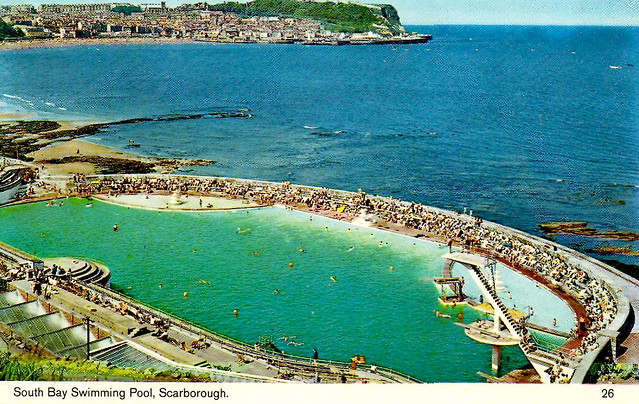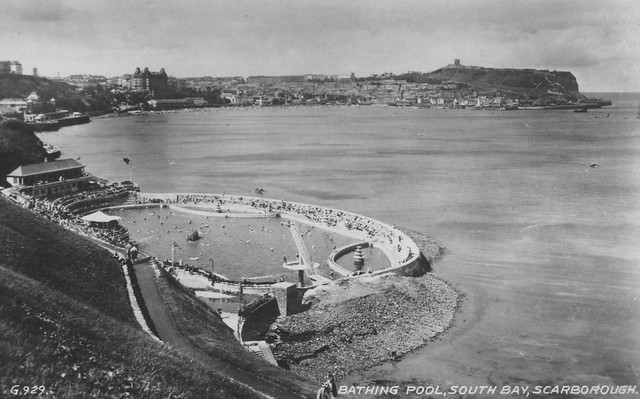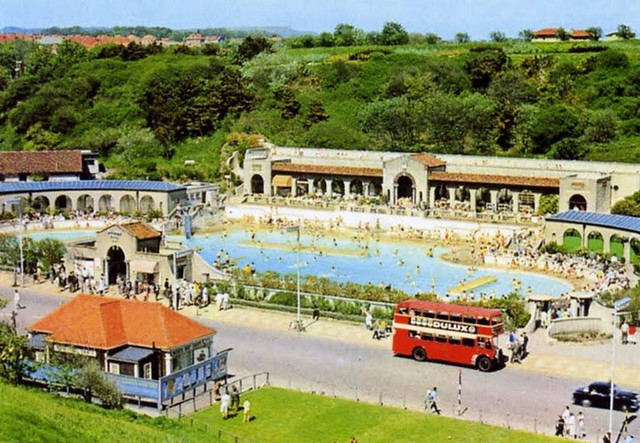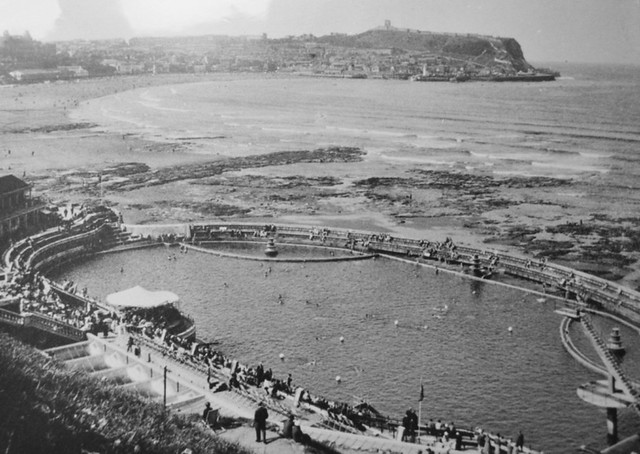Beyond the Spa and the South Bay bathing huts in Scarborough, is a large expanse of concrete. Now a star map, it covers what was once the South Bay Bathing Pool, one of the town’s most popular attractions.
Above: The South Bay Pool (source)
The pool was one of many masterpieces designed by Scarborough’s former Borough Engineer, Harry W. Smith, who was responsible for Peasholm Park, Floral Hall and Northstead Manor Gardens, to name just a few of the attractions that came to define his glittering career. Under his guidance much of the town was transformed into a haven for tourists, and his legacy can still be seen across Scarborough today.
Above: The pool was part of a large scale redevelopment of the area beyond the Spa (source)
Harry W. Smith apparently thought of the idea – for an outdoor pool – after a visit to Guernsey, which already had an open air tidal pool for bathers. The pool he proposed would be the first of its kind in Britain, and would include diving boards, water chute, different depths, changing rooms and showers etc. This would exceed existing seaside provision for bathers, which was rather meagre – the North Bay Bathing Pool would not be built until the 1930s and those who wanted to swim often headed for the sea, accompanied by a cumbersome bathing machine.
Above: The North Bay Pool did not open until the 1930s (source)
Construction began shortly before the outbreak of WWI, and was taking place in December 1914, when Scarborough was bombarded by German ships. Workers were able to shelter, coincidentally, behind the new wall they had recently constructed for the pool.
Above: The early days of the South Bay Pool (source)
The pool was part of a larger development including the Clock Cafe, gardens, cliffside paths and beach bungalows that had enjoyed such popularity when they were introduced along the North Sands earlier in 1910. This newly developed area in the south, just beyond the Spa, helped accommodate the growing crowds of holidaymakers, and the pool in particular was vast. Built in the Art Deco style, it measured 330ft long and 167 ft wide, and was filled naturally by fresh sea water, propelled into the pool by the tide each day. Officially opened in 1915, the pool later hosted national competitions, such as the Amateur Swimming Association championships, and provided a training ground for more serious swimmers, some of whom would go on to swim the Channel – more on this to come in a future post!

Above: One of the original diving boards at the pool (source)
It has also been reported that the pool may have been designed in such a way as to protect against coastal erosion . Either way, it provided a picturesque, family friendly spot, where visitors of all ages – bathers and non-bathers, could enjoy themselves.
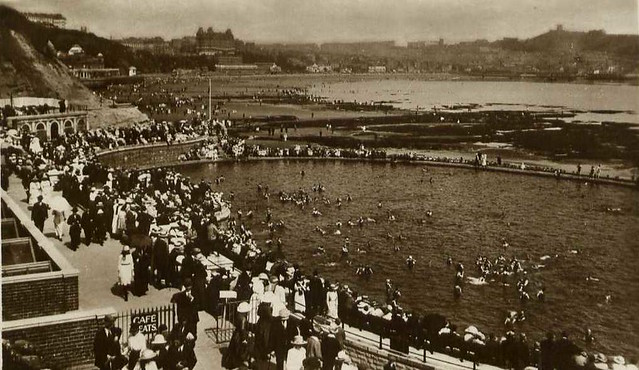
Above: Many visitors simply came to admire the displays of swimming and diving (source)
In 1935, due to popular demand, the pool was subject to a number of improvements, which included additional seating for audiences, who enjoyed the many competitions and aquatic displays hosted at the venue, better changing facilities and new fountains for children.
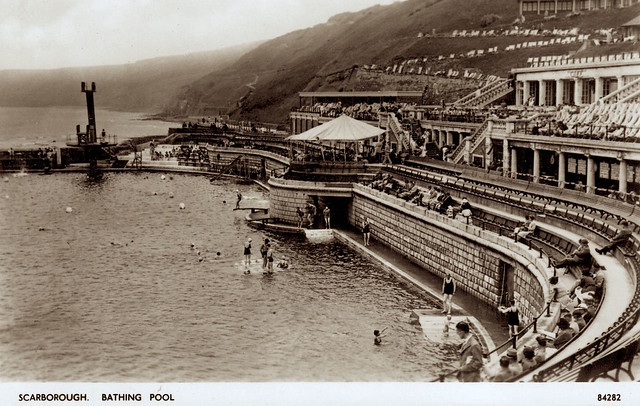
Above: The pool provided substantial seating areas for visitors (source)
There are several videos online that offer tantalising glimpses of the pool at various stages in its history – some examples are included below:
Video 1 (1939) 1:33 onwards
Video 2 (1957) 5:19 onwards
Video 3 (1980s)
Video 4 (2000) shortly before demolition
Visitors to the Stories From Scarborough Facebook Page have shared some lovely memories of the pool.
From Fee:
Ah, many a day was spent during the summer hols in this pool. Who remembers being able to take inflatable’s into the pool; the Victorian changing rooms and the mangle to wring out your cossie?
From Tony:
I spent wonderful summers here, swimming all day and chatting with friends, leaning over the outer wall at high tide and watching enormous eels swim by…
From Dave:
Picture this, a foggy morning, the fog horn monotonous ghostly call and a crocodile fashion of school boys winding their way down the ‘south cliff’, the pool down in the distance, looking about as welcoming as the North Sea itself……The lighter green area is where we had to do 2 lengths in order to satisfy the teachers that all new boys could swim. So long ago, but the memory of chattering teeth and hyperventilation during the test (mid May 1969) and over active imagination….and this is before Peter Benchley’s Jaws!!… This picture is a fine example of how people wanted it to be like, but in reality…shhhhivvvvver!
I did the top board ! I remember sitting on the edge and slipping off ! I remember it was so cold ! My mother took me to the open pool every day in our summer holidays ! I also remember they may of had a small board around the pool apart from the main three !! Happy days I was only a very young man !
Check out the album for this attraction on the Stories From Scarborough Facebook Page for more memories and comments – there were too many brilliant ones to include them all here.
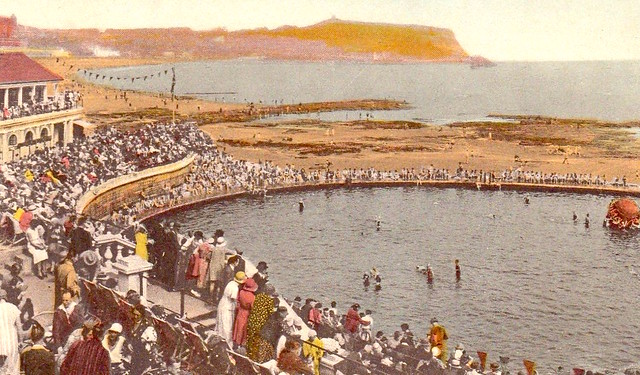
Above: The pool in its heyday (source)
The pool closed in 1989 – the diving boards were taken down, although the fountains remained and the facilities slowly fell into dereliction and decay. Attempts were made to save it from being filled in – the Twentieth Century Society, for instance, put forward some strong arguments for its historical value, but in the early 2000s it was redeveloped, and all traces of the pool, except for its distinctive outline, have since disappeared.
Sources
Scarborough Civic Society
The Twentieth Century Society
Scarborough News
Materials held at the Scarborough Room at Scarborough Library
Sea Bathing and the First Bathing Machine at Scarborough: Part I
This is an article originally published in the Yorkshire Journal (Spring Issue, 2012) by Sarah Harrison. She has kindly given permission for her work to be republished here.
Sea Bathing and the First Bathing Machine at Scarborough
Scarborough rapidly became a fashionable spa town and the first original English seaside resort after the discovery, in about 1626 (by a Mrs. Farrer) of natural mineral springs at the South Bay. It also saw the arrival of the first bathing machines in 1735.
“Taking the Waters” quickly became Scarborough’s accepted medicine and its fame promptly spread.
Dr Robert Wittie of Hull was the main medical supporter promoting the mineral waters, and in 1660 he published his book Scarborough Spa, in which he proclaimed “the waters” as a cure for all ills. He also began promoting the health benefits of sea bathing. Furthermore, at around 1730, Peter Shaw, a popular spa doctor and chemist in Scarborough wrote about the advantages of ‘Bathing in the Sea’ at the end of his ‘Dissertation upon the Scarborough Waters’.
Indeed, at this time, doctors began promoting sea-bathing as a healthy pastime. They gave plenty of advice on the best way to bathe: briefly, healthy males for five minutes before breakfast daily; the ‘weaker sex’, invalids and children for three dips of two minutes duration three hours after breakfast three times a week!
To encourage sea bathing a horse-drawn box on wheels could be hired to take the bather out into the sea, enabling the occupier to undress before ‘dipping’ in the sea.
Above: John Setterington’s engraving of the first bathing machine at Scarborough, 1735. The engraving shows an elaborate wooden hut on four wheels, with a window, located close to the water with an attendant holding the door open for a bather. A carriage rider and three people, one with a horse, are visible on the beach. In the sea nearby are four swimmers. This engraving s the first recorded evidence of the use of a bathing machine, and can be seen in Scarborough Public Library where copies are available for sale (published here via the Yorkshire Journal, Spring Issue, 2012)
The bathing machines was first pioneered at Scarborough’s seaside resort for women, who entered the sea clad in vast garments, helped by female servants, from horse drawn wooden sheds on wheels. It was quite acceptable for men to bathe or swim naked from boats or the sands. When the railways came, in 1845, greater numbers of trippers crowded onto the beach. Rules were quickly introduced specifying bathing areas, distances to be kept between men and women and bathing clothes to be worn, from 7 a.m. to 9 p.m.
Above: The gentry at the popular seaside town of Scarborough in 1776. A number of bathing machines can be seen on the seashore – two are close to the sea itself (via the Yorkshire Journal, Spring Issue, 2012)
Respectability was enforced, but attitudes changed in 1871 when it was thought absurd that a ‘house’, a horse and an attendant were necessary to get someone into the sea. By 1904 Scarborough had bathing tents beyond the Spa and on the North Sands.
Above: The North Bay at Scarborough, looking south towards Castle Hill on the headland and the new Marine Drive. This old photo shows the beach populated with holidaymakers, deck chairs and bathing machines (via the Yorkshire Journal, Spring Issue, 2012)
Above: This old photo shows the Grand Hotel, which was completed in 1867, being one of the largest hotels in the world and one of the first purpose-built hotels in Europe. The cliff tram does not appear in the photo – it was built in 1875 after this photo was taken. On the sands below are a number of bathing machines awaiting the day’s bathers. The horses await their turn to draw the machines with their occupants into the sea (via the Yorkshire Journal, Spring Issue, 2012)
The bathing machines in the photo are Walshaw’s and Browne’s. Other Scarborough proprietors were Morrison, Crosby and Rawling. Mr Rawling also owned Rawling’s Field, close to the North Bay, which he eventually sold to the Scarborough Corporation for the development of the North Bay Bathing Pool.
To be continued…
Sources
To see the article in its original format, please visit the Yorkshire Journal (Spring, 2012). All copyright retained by the author.
Many thanks to Sarah for sharing this article with Stories From Scarborough! Look out for part 2, coming soon…
Captain Webb at Scarborough Aquarium
Swimming has, unsurprisingly, proved to be a popular theme here at Stories From Scarborough. From the epic sprawling slides of Atlantis to the glamour of the South Bay Pool in the 1920s, water sports of various kinds have long been a part of Scarborough’s enduring appeal.

Above: Even surfers come flocking to Scarborough (source)
Whilst pictures of the North and South Bay bathing pools (and of course the sea!) are plentiful, those of Scarborough Aquarium (later to become Gala Land) are harder to come by. Not initially known as a swimming venue, the aquarium’s early appeal (following its 1877 construction) came from its collection of sea life.
However, one bold swimmer changed this.

Above: Captain Matthew Webb (source)
Captain Matthew Webb was a famed swimmer – his list of achievements includes being the first to swim the English channel without artificial aids – a feat that took him 21 hours and 45 minutes.

Above: Crowds greet Webb at Calais (source)
Following several unsuccessful attempts, an unrelenting Captain Webb, smeared in porpoise oil, dived off Dover Pier on August 24th, 1875. He endured jellyfish stings and strong currents before reaching the shores of Calais.
Never shall I forget when the men in the mailboat struck up the tune of Rule Britannia, which they sang, or rather shouted, in a hoarse roar. I felt a gulping sensation in my throat as the old tune, which I had heard in all parts of the world, once more struck my ears under circumstances so extra-ordinary. I felt now I should do it, and I did it.
(source)
Never one to shy away from a challenge, Matthew Webb was born in 1848; son of a surgeon and eldest of seven children. He grew up in Shropshire and learned to swim in the River Severn.

Above: The River Severn is the longest river in the UK (source)
At the age of twelve he embarked on a seafaring career, and at fifteen he saved his younger brother from drowning in the Severn- the river where his love affair with swimming began.
Above: The rescue took place near Ironbridge, Shropshire (source)
Years later Captain Webb added further exploits to his growing reputation – he dived under his ship in the Suez canal and also receiving a medal for attempting to rescue a fellow crew member who fell overboard near Russia. In a bid to further his swimming career, he abandoned life at sea for training at Lambeth Baths. Webb had heard about a failed attempt to swim the channel, and was determined to have a go.

Above: Lambeth Baths – specially designed pools and bathing houses started to replace so-called ‘wild swimming’ for many during the late 1800s (source)
Following his successful channel swim, Matthew Webb was highly sought after and competed in numerous challenges both at home and abroad – usually for a significant fee. As part of his whistle-stop tour he allegedly spent 74 hours in the Scarborough Aquarium, in August, 1880. With only a four minute break he swam virtually non-stop for the entire duration – an incredible feat which must have been exhausting to watch, let alone swim!
An 1880 print by John Jellicoe depicts a similar feat (60 hours) at Westminister Aquarium – click here to see it.
There are some minor disagreements as to the exact nature of this water marathon – some sources say he swam, others say he was treading water. Even the length of time has been debated, for instance the San Francisco Mail and other publications argued (or perhaps misreported) that the swim lasted 60 hours.

Above: An apt motto for a memorial in Webb’s birthplace – Dawley in Shropshire (source)
Only three years after the struggling aquarium opened, one can only presume that Webb’s presence was designed to attract much-needed visitors; a ploy which ultimately failed in the long term – the aquarium was sold only years later due to low visitor numbers.
Above: Extract from the Times, 1880 (source)
Captain Webb’s pursuit of danger, fame and fortune sadly led to a premature death. Aged just 35 years old, an afternoon swim near Niagara Falls ended in tragedy after Webb was sucked into a whirlpool, hit the rocks and subsequently died. He had been pursuing a princely sum of £12,000, which would be awarded following a successful swim through the tempestuous waters. Tragically he appears to have underestimated their power.

Above: Niagara Falls in Canada (source)
In 2012, as part of an arts project in Scarborough , people were filmed treading water for a film/projection entitled ‘74 Seconds’ – a nod to Webb’s 74 hour stunt in Scarborough Aquarium. Indeed, Captain Matthew Webb has certainly not been forgotten, although is understandably best remembered for his pioneering Channel swim, rather his subsequent celebrity appearances.
Sources
Heroes of Swimming (The Guardian)
Swimming in Scarborough: Battle of the Bathing Pools
Swimmers have always been welcome in Scarborough. Over the years the town has featured numerous pools – outdoor and indoor included. The North Bay Bathing Pool (which later became Waterscene, Water Splash World, and then Atlantis) has already been mentioned here.

Above: The early days of the North Bay Bathing Pool (source)
Following its creation in 1938, the North Bay Bathing Pool played second fiddle to the better known and older South Bay Pool – a large seawater pool located near the Spa.
Above: The South Bay Pool (source)
Built in 1915, this pool was once a glamorous hotspot complete with diving boards, swimming exhibitions and competitions.

Above: The pool featured on a 1920s rail poster (source)
The pool was also designed to function as a wave barrier, and was subject to the tempestuous moods of the sea. It opened in July 1915 not long after WWI began, and less than a year after Scarborough was attacked by German forces on December 16th, 1914.

Above: The attack on Scarborough was later used to encourage men to enlist (source)
Below: The new pool (source)

Designed by borough engineer Harry W. Smith, the pool measured 330ft by 165ft in size and featured a 32ft high diving board – it was once the largest outdoor pool in Europe. Audiences were treated to a variety of shows, exhibitions and events featuring swimming, diving and aquatic displays.
Above: South Bay Pool in 1922 (from the author’s personal collection)
In 1935 audience seating capacity was increased, diving boards and changing rooms were added and fountains were created for children. However, only three years later the pool had a new rival, albeit a smaller one. The North Bay Bathing Pool, which opened in 1938 measured 250ft by 60ft, was located not far from the quieter North Sands.
Above: North Bay Bathing Pool (source)
This second, smaller pool played a key role in enticing visitors to visit Scarborough’s North Bay, which was rapidly establishing a formidable array of new attractions. Both pools were, at various points, used by Scarborough Swimming Club.
However, in the 1980s, the North Bay Bathing Pool was given a dramatic makeover that would see it take the edge in the competition of the outdoor pools. It reopened in 1984 as Waterscene, boasting the longest water chute in the world. Subsequent re-developments modernised the pool, and the new slides and themed areas were a success in attracting tourists, especially children.
Above: An aerial view of the newly developed North Bay Pool, photographed by Michael Jaconelli (image sourced from here)
The South Bay Pool, after a heyday particularly notable in the 1930s, 40s and 50s, remained popular with visitors, but for numerous reasons (viability, local politics and problems with upkeep are all cited to varying degrees) closed in 1988. The structure stood for fifteen more years, becoming flooded and derelict until the area was finally demolished in 2003. After being filled in, the pool is now the site of a star map.
You can see a picture of the site today by clicking here. Tiny lights show star positions at night, and there is an information board also.
Whilst the North Bay Bathing Pool appears to have emerged victorious in the bathing pool battle (in terms of longevity at least), its days too were numbered. Following two rebrandings (first to Water Splash World, then to Atlantis), the pool eventually suffered the fate of many outdoor UK pools – it closed in 2007, and was subsequently demolished. It is now the site of the Military Adventure Park.
Above: The Military Adventure Park (source)
Holidaymakers can now easily visit affordable resorts abroad that boast not only extensive water parks, but also guarantees of hot sunny weather to complement the experience. Years ago visitors had fewer options, and towns such as Scarborough reaped the benefits.
Above: North Bay Bathing Pool postcard (from the author’s personal collection)
Scarborough still has an indoor pool, and many still swim in the sea. However, it is easy to forget that swimming events and exhibitions once took place across the town, from the underground pool at Gala Land, to Peasholme Park Lake and the boating lake near the Open Air Theatre. There was also Bland’s Cliff Swimming baths (now Coney Island Amusements).
Although most of the aforementioned pools are long gone, swimmers (and paddlers!) will always be drawn to the oldest pool of all – the sea itself.
Do you remember any of the swimming pools mentioned? Or perhaps you know of others? Please contribute comments, corrections, or any information below.
Sources

